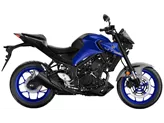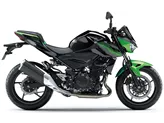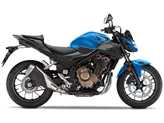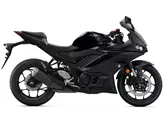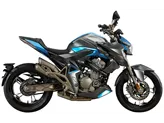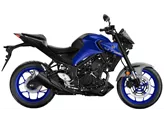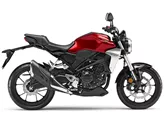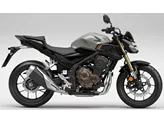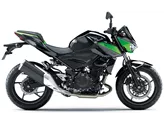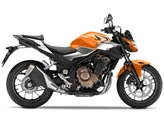Yamaha MT-03 2019 vs. Kawasaki Z 400 2019

Yamaha MT-03 2019

Kawasaki Z 400 2019
Vue d’ensemble - Yamaha MT-03 2019 vs Kawasaki Z 400 2019
The Yamaha MT-03 2019 and the Kawasaki Z 400 2019 are both naked bikes that offer a thrilling riding experience. While they have several similarities in terms of engine type, suspension, and frame, there are also some notable differences between the two models.
In terms of engine specifications, the Yamaha MT-03 2019 is equipped with an in-line, liquid-cooled engine with a displacement of 321cc. It produces 42 horsepower and 29.6 Nm of torque, making it a powerful option for riders. On the other hand, the Kawasaki Z 400 2019 features a slightly larger engine with a displacement of 399cc. It delivers 45 horsepower and 38 Nm of torque, providing a slightly higher power output than the Yamaha MT-03.
Both bikes come with a telescopic fork front suspension and a swing arm rear suspension with a monoshock absorber. This setup ensures a smooth and comfortable ride, absorbing bumps and providing stability on the road. The chassis of the Yamaha MT-03 2019 is made of steel and features a twin tube frame, while the Kawasaki Z 400 2019 has a steel frame with a tubular design. These chassis designs contribute to the overall stability and handling of the bikes.

Yamaha MT-03 2019
In terms of braking performance, both bikes are equipped with a single disk front brake. However, the Kawasaki Z 400 2019 has a larger front brake diameter of 310mm compared to the Yamaha MT-03 2019's 298mm. This larger brake diameter may provide slightly better stopping power for the Kawasaki Z 400.
Both the Yamaha MT-03 2019 and the Kawasaki Z 400 2019 come with ABS, which is an advanced rider assistance system that enhances safety by preventing wheel lock-up during braking. This feature is especially beneficial for novice riders who may not have as much experience with emergency braking situations.
When it comes to dimensions and weights, the Yamaha MT-03 2019 has a front tire width of 110mm and a rear tire width of 140mm, while the Kawasaki Z 400 2019 has a slightly wider rear tire width of 150mm. Both bikes have a wheelbase of around 1370-1380mm, providing stability and maneuverability. The seat height of the Yamaha MT-03 2019 is 780mm, while the Kawasaki Z 400 2019 has a slightly higher seat height of 785mm. The kerb weight of both bikes is relatively similar, with the Yamaha MT-03 2019 weighing 168kg and the Kawasaki Z 400 2019 weighing 167kg.

Kawasaki Z 400 2019
In terms of strengths, the Yamaha MT-03 2019 is praised for its well-controllable power, low seat height, easy rideability, low fuel consumption, easy-to-read LCD display, and aggressive look. On the other hand, the Kawasaki Z 400 2019 is commended for its great and very controllable power delivery, low weight, good seating position, great sound, and suitability for novice riders.
However, both bikes also have some weaknesses. The Yamaha MT-03 2019 may have a sharp knee angle for taller riders and a softer chassis compared to other Yamaha MT models. It is also considered to be less emotionally engaging compared to some other motorcycles. The Kawasaki Z 400 2019 has non-adjustable clutch and brake levers, which may limit customization options for riders. Additionally, the chassis of the Kawasaki Z 400 2019 is not as adjustable as some other models, which may limit the bike's adaptability to different riding styles.
In conclusion, the Yamaha MT-03 2019 and the Kawasaki Z 400 2019 are both powerful and capable naked bikes. While they share similarities in terms of engine type, suspension, and frame, they also have some differences in terms of power output, braking performance, and adjustability. Ultimately, the choice between the two models will depend on the rider's preferences and priorities.
Caractéristiques techniques Yamaha MT-03 2019 par rapport à Kawasaki Z 400 2019
Avantages et inconvénients en comparaison
Avantages et inconvénients en comparaison
Yamaha MT-03 2019

La MT-03 est et reste l'Hyper Naked la plus accessible et la plus pragmatique de Yamaha dans le segment. Elle marque des points avec sa hauteur de selle basse, la puissance bien dosée de son bicylindre et offre en même temps suffisamment de confort pour les pendulaires. Ce qu'il lui manque peut-être en sportivité, elle le compense par son grand confort et convient donc parfaitement aux personnes qui cherchent une moto qui fonctionne bien avec un look brutal. Il ne faut toutefois pas être trop grand et ne pas avoir la prétention de pouvoir rivaliser avec les autres modèles de la gamme MT à l'épingles - elle n'a en effet pas été conçue pour cela. L'année modèle 2020 est donc une mise à jour cohérente qui fera certainement le bonheur de ses acheteurs.
Kawasaki Z 400 2019

La Kawasaki Z400 est en tout cas une belle évolution du modèle précédent Z300. Plus de puissance, moins de poids - tout simplement une moto encore meilleure. Le développement linéaire de la puissance et l'excellente maniabilité font de la Z400 une moto idéale pour les débutants. La facilité d'actionnement de l'embrayage et la bonne configuration du châssis vont également dans ce sens, raison pour laquelle la Z400 peut être recommandée sans hésitation aux pilotes débutants.
Comparaison des prix Prix moyen du marché Yamaha MT-03 vs Kawasaki Z 400
There are a few key differences between a Yamaha MT-03 2019 and a Kawasaki Z 400 2019. It takes less time to sell a Yamaha MT-03 with 89 days compared to 99 days for a Kawasaki Z 400. Since model year 2006 1000PS.de editors have written 8 reviews for the Yamaha MT-03 and 8 reviews for the Kawasaki Z 400 since model year 2019. The first review for the Yamaha MT-03 was published on 12/15/2005 and now has more than 109,900 views. This compares to more than 23,200 views for the first review on Kawasaki Z 400 published on 10/2/2018.


